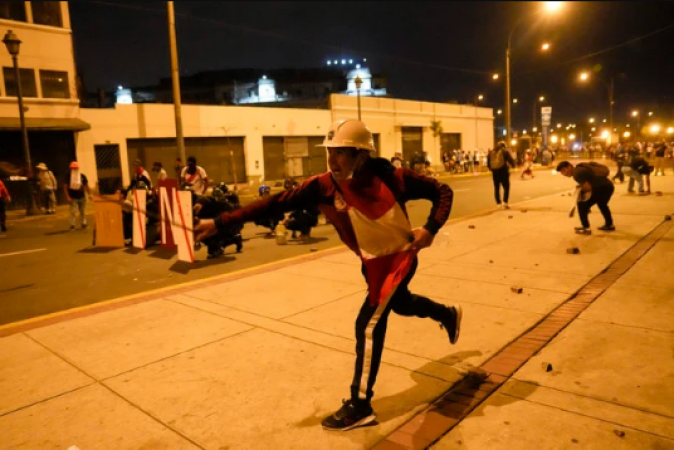
LIMA: Thousands of Peruvian protesters, many from the country's south, thronged the capital Lima on Thursday, angered by the rising death toll since the unrest that began last month, and demanding radical change. Others believe the march attracted more people than the police estimate of 3,500.
On some streets, lines of riot police clashed with stone-throwing protesters, and a historic structure was set on fire late Thursday in the city's historic district. According to a firefighter commander, the San Martin Plaza building was unoccupied when the massive fire broke out and started for unknown reasons.
As people in poor, rural areas vent their fury at the Lima establishment over inequality and rising prices, the past month has seen raucous and sometimes deadly protests that have tested the copper-rich Andean nation's democratic institutions and most Bad violence has happened in Peru. seen in two decades.
Also Read: Russia-Ukraine War impact on the global food supply chain
The market-friendly constitution from the time of right-wing strongman Alberto Fujimori in the 1990s is to be changed, according to the protesters, who also call for the resignation of President Dina Boluarte, immediate elections and other demands.
José de la Rosa, a protester, predicted that the street demonstrations would only intensify and said, "We want the usurper Dina Boluarte to step down and call for new elections."
Leftist former President Pedro Castillo was abruptly removed from office on 7 December after attempting to shut down Congress and consolidate power.
On Thursday, thousands of people traveled by bus and on foot to Lima, carrying flags and banners condemning police and the government for deadly clashes in the southern cities of Ayacucho and Juliaca. Outside the capital, unrest was widespread.
Also Read: 'Pak will break into many pieces this year..,' says Muqtedar Khan
Authorities in southern Arequipa announced a suspension of operations at Arequipa and Cusco airports after police used tear gas on hundreds of protesters who attempted to take over the airport, as seen on local television.
The government ombudsman reports that there have now been 45 deaths, with a woman from the southern Puno region becoming the latest victim on Thursday, who succumbed to wounds sustained the day before.
Accidents linked to the protest blockade have been blamed for the nine additional deaths. According to transport officials, roads were visible in 18 of the 25 regions, demonstrating the prevalence of protests across the country.
Political leaders urged calm while police increased surveillance of roads leading to Lima. Last week, the troubled Boluarte administration extended a state of emergency that restricted some civil rights in Lima and the southern regions of Puno and Cusco.
Peru's Interior Minister Vicente Romero told reporters, "We don't want more deaths, we don't want more injuries, enough blood and enough grief for Peruvian families.
Despite the fact that protester banners describe Bolluarte as a "murderer" and refer to the killings of security forces as "massacres", Bolluarte has pleaded for an "apology" for the protest deaths. He has refused requests to resign.
Human rights organizations claim that the police and army used lethal weapons during the protests. According to the police, the protesters have used explosives and weapons.
Also Read: Crude down; Harbor Energy to lay off workers due to UK windfall tax
“We will not forget the suffering inflicted by the police in the city of Juliaca,” said a protester traveling to Lima, referencing the city where protests turned particularly violent earlier this month. “We – the men, Women and children - must fight."
Other protesters cited a strategic justification for attacking the coastal capital. "We want to centralize our movement in Lima, the heart of Peru, to see if they go away," said Domingo Cueva, a protester who came from Cusco. We've seen more repression everywhere, he continued.